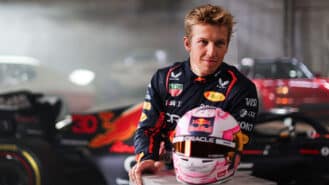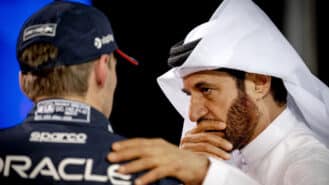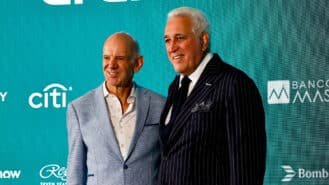A series taken from the 164-page Motor Sport special Great Racing Cars, which is available to buy here
From Parnelli Jones – 1960s US racing legend, 1970s F1 team owner

My favourite race car for sure is ‘Calhoun’. Not only did I win the Indianapolis 500 in that car in 1963, but I was also the first driver to lap the Indianapolis Motor Speedway at over 150mph in that car in 1962.
The car ran at Indianapolis for five years and not too many Indy cars run that competitively for so many years. Lloyd Ruby drove ‘Calhoun’ in 1960 and I drove it in 1961, ’62, ’63 and ’64. I led a lot of laps at Indianapolis in ‘Calhoun’ and could have won in my rookie year, 1961, until I lost a cylinder. The next year I led again with ‘Calhoun’ but ran out brakes before we finally won the 500 in 1963. So that car meant a lot to me.
The first year I ran at Indianapolis, when you got sideways the experienced guys would tell you not to do that. They said if you have to start turning the car the other way you were going to spin it and hit the wall and we saw Jack Turner do exactly that.
One time during practice in my rookie year, I came out of turn four and got sideways. I corrected just a little bit and it was a miracle that I kept it out of the wall. That taught me that the next time the car did that I was going to be ahead of it.
I led the race for 27 laps in my rookie year and had a chance to win until we lost that cylinder. After the race I got a chance to do some tyre testing for Firestone. I ran around 1500 miles and by the end of the test the gearshift and everything else were falling apart.

But during those tyre tests I learned how to slip the car and be ahead of it. I learned how to slip the car on purpose, so I could come off the corners with the car running freer and keep my speed up, which was one of the reasons I had an edge with that car. In those days the tyres were tall and skinny and the drivers were fat compared to today’s young guys.
I get a chance to drive ‘Calhoun’ every once in a while at Indianapolis and it’s like putting on an old glove. I gave that car it’s name. One day I said, ‘Let Calhoun have the ball’. And from then on, it took on that name. We put a lot of happy miles in that car.
Not in my Brickyard
How Parnelli Jones withstood the European invasion at Indianapolis in 1963
Nobody was more determined to prevent the European dog from cocking its leg in Gasoline Alley than Parnelli Jones. He was 29 years of age then, a tough individual born into a poor Arkansas family that had drifted west to California during the dark days of the Depression. This would be only his third start in the Indy 500, but already he had made his mark on the Speedway.
In 1961, his rookie year, he had started from the second row of the grid and led for 75 miles despite the handicap of blood filling the left eyepiece of his goggles after a piece of flying metal cut his forehead. It wasn’t until the Offy engine of his Watson-built roadster went off song that Jones conceded the lead, although he battled all the way to the end to finish 12th. In 1962 he qualified on pole, with the first 150mph-plus run for the flying four laps, and led the race until brake problems intervened.
Jones’s car in 1963 was the same Watson-Offy roadster he’d raced in 1961 and 1962. Known as ‘Ol’ Calhoun’, it was sponsored and entered by J C Agajanian, a pig farmer and garbage collector who had been running cars at the Speedway since 1948 but was still looking for his first win. Ol’ Calhoun was a state-of-the-art USAC roadster, which weighed in at 1500lbs against the Lotus’s 1150lbs and looked as big as a bus by comparison.
High winds were gusting over the track when qualifying started. Wind speeds of above 35mph were being recorded when Jones fired up Ol’ Calhoun and set off. The target to beat was 150.188mph, set by veteran Don Branson, also driving a Watson-Offy. Jim Clark and Dan Gurney had yet to run. Jones had developed a special technique for qualifying at the Speedway, a style he kept to himself and never used when somebody was running close enough to see what he was up to. Coming into a corner, he tapped the brakes and threw the car into a slide. It was done at high enough speed to force the outer edge of the outside rear tyres to tuck under. The moment the car stopped sliding, the tyre popped back up, fully erect, slingshotting ‘Ol’ Calhoun’ down the straight. Jones reckoned it gave him another 2-3mph. But if it was fast, it was also risky, if the front wheels weren’t pointed straight down the road when he floored the throttle, the popped-up tyre would catapult the car into a slide in the opposite direction and straight into the wall at 140mph. It had happened to other drivers, who had inadvertently created the same effect. Right from the beginning of that run it was clear that Jones was on the ragged edge, the high winds snatching at the front end of the car. Not once did he let up though and the crowds in the grandstand responded to what they could see was a huge effort of guts and will. His fastest lap was 151.847mph, his four-lap average 151.153mph. Veteran commentator Torn Carnegie yelled: “A new track record”, and Jones, the adrenalin subsiding, cruised slowly into the pits.
Neither Clark nor Gurney could do anything about it. Gurney badly damaged one chassis trying and dropped to 13th on the grid. Clark averaged 149.750mph to take fifth. Asked for his reaction afterwards, Jones said: “The last thing in the world I was going to see happen was one of them goddam funny cars take the pole.”

Jones won somewhat controversially because Ol’ Calhoun had been leaking oil in the closing stages, normally an instant case for a black flag. Clark was second, a victim of some sharp practice by the USAC establishment. But when American driver Eddie Sachs, who had crashed out on the spilt oil, raised the issue with Jones, the only reply he got was a punch in the face. It wasn’t gracious, but the way Jones drove that car had earned him the right.
Taken from the October 1997 issue of Motor Sport
To read more related stories visit motorsportmagazine.com/archive







